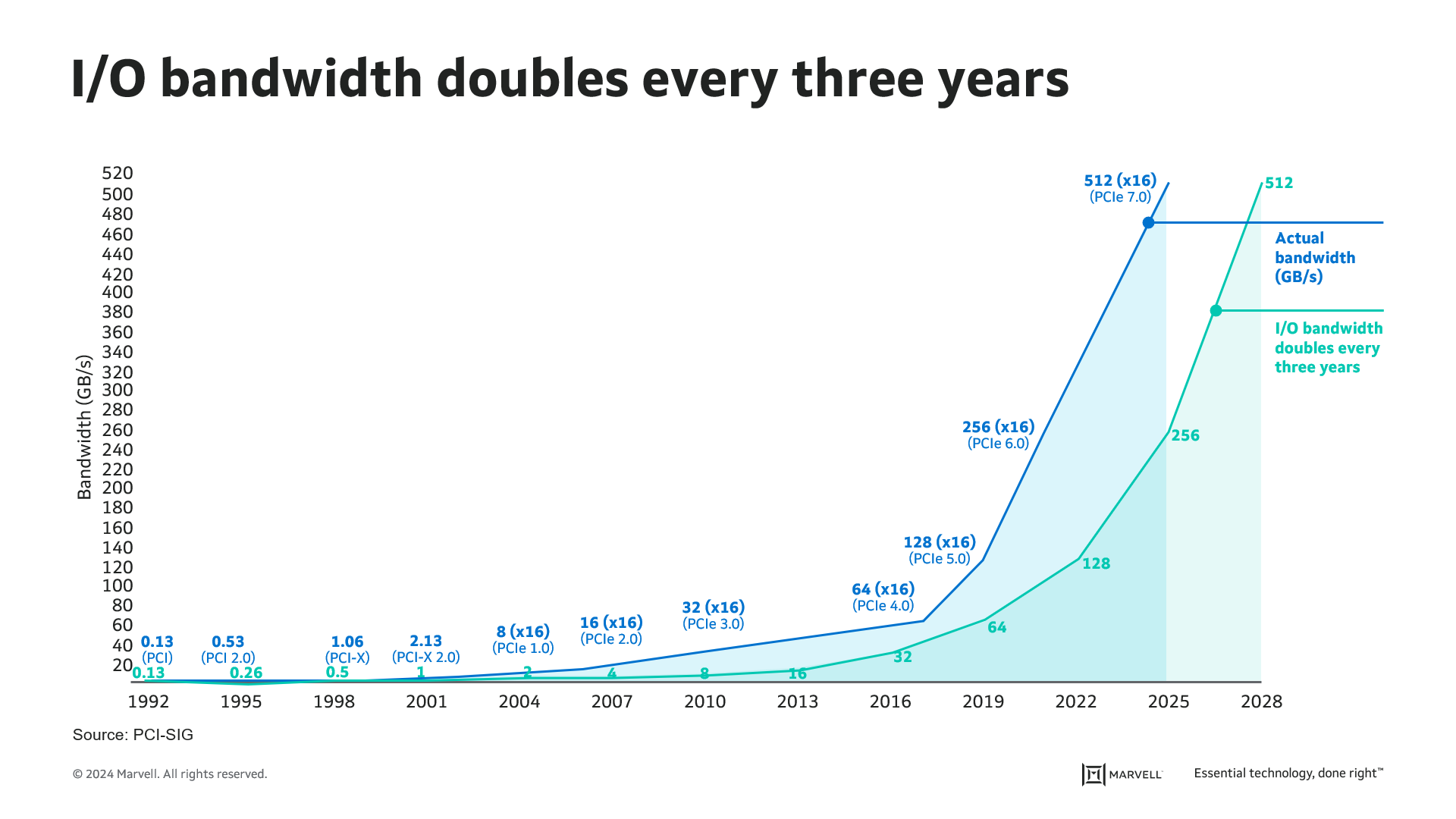Archive for the 'Optical Modules' Category
-
January 25, 2024
How PCIe Interconnect is Critical for the Emerging AI Era
By Annie Liao, Product Management Director, Connectivity, Marvell
PCIe has historically been used as protocol for communication between CPU and computer subsystems. It has gradually increased speed since its debut in 2003 (PCI Express) and after 20 years of PCIe development, we are currently at PCIe Gen 5 with I/O bandwidth of 32Gbps per lane. There are many factors driving the PCIe speed increase. The most prominent ones are artificial intelligence (AI) and machine learning (ML). In order for CPU and AI Accelerators/GPUs to effectively work with each other for larger training models, the communication bandwidth of the PCIe-based interconnects between them needs to scale to keep up with the exponentially increasing size of parameters and data sets used in AI models. As the number of PCIe lanes supported increases with each generation, the physical constraints of the package beachfront and PCB routing put a limit to the maximum number of lanes in a system. This leaves I/O speed increase as the only way to push more data transactions per second. The compute interconnect bandwidth demand fueled by AI and ML is driving a faster transition to the next generation of PCIe, which is PCIe Gen 6.

PCIe has been using 2-level Non-Return-to-Zero (NRZ) modulation since its inception. Increasing PCIe speed up to Gen 5 has been achieved through doubling of the I/O speed. For Gen 6, PCI-SIG decided to adopt Pulse-Amplitude Modulation 4 (PAM4), which carries 4-level signal encoding 2 bits of data (00, 01, 10, 11). The reduced margin resulting from the transition of 2-level signaling to 4-level signaling has also necessitated the use of Forward Error Correction (FEC) protection, a first for PCIe links. With the adoptions of PAM4 signaling and FEC, Gen 6 marks an inflection point for PCIe both from signaling and protocol layer perspectives.
In addition to AI/ML, disaggregation of memory and storage is an emerging trend in compute applications that has a significant impact in the applications of PCIe based interconnect. PCIe has historically been adopted on-board and for in-chassis interconnects. Attaching more front-facing NVMe SSDs is one of the common PCIe interconnect examples. With the increasing trends toward flexible resource allocation, and the advancement of CXL technology, the server industry is now moving toward disaggregated and composable infrastructure. In this disaggregated architecture, the PCIe end points are located at different chassis away from the PCIe root complex, requiring the PCIe link to travel out of the system chassis. This is typically achieved through direct attach cables (DAC) that can range up to 3-5m.
-
October 19, 2023
走近 AI 时代下的 Marvell 光学技术与创新
By Kristin Hehir, Senior Manager, PR and Marketing, Marvell
The sheer volume of data traffic moving across networks daily is mind-boggling almost any way you look at it. During the past decade, global internet traffic grew by approximately 20x, according to the International Energy Agency. One contributing factor to this growth is the popularity of mobile devices and applications: Smartphone users spend an average of 5 hours a day, or nearly 1/3 of their time awake, on their devices, up from three hours just a few years ago. The result is incredible amounts of data in the cloud that need to be processed and moved. Around 70% of data traffic is east-west traffic, or the data traffic inside data centers. Generative AI, and the exponential growth in the size of data sets needed to feed AI, will invariably continue to push the curb upward.
Yet, for more than a decade, total power consumption has stayed relatively flat thanks to innovations in storage, processing, networking and optical technology for data infrastructure. The debut of PAM4 digital signal processors (DSPs) for accelerating traffic inside data centers and coherent DSPs for pluggable modules have played a large, but often quiet, role in paving the way for growth while reducing cost and power per bit.
Marvell at ECOC 2023
At Marvell, we’ve been gratified to see these technologies get more attention. At the recent European Conference on Optical Communication, Dr. Loi Nguyen, EVP and GM of Optical at Marvell, talked with Lightwave editor in chief, Sean Buckley, on how Marvell 800 Gbps and 1.6 Tbps technologies will enable AI to scale.
-
June 27, 2023
利用高速光学连接扩展人工智能基础设施
By Suhas Nayak, Senior Director of Solutions Marketing, Marvell

In the world of artificial intelligence (AI), where compute performance often steals the spotlight, there's an unsung hero working tirelessly behind the scenes. It's something that connects the dots and propels AI platforms to new frontiers. Welcome to the realm of optical connectivity, where data transfer becomes lightning-fast and AI's true potential is unleashed. But wait, before you dismiss the idea of optical connectivity as just another technical detail, let's pause and reflect. Think about it: every breakthrough in AI, every mind-bending innovation, is built on the shoulders of data—massive amounts of it. And to keep up with the insatiable appetite of AI workloads, we need more than just raw compute power. We need a seamless, high-speed highway that allows data to flow freely, powering AI platforms to conquer new challenges.
In this post, I’ll explain the importance of optical connectivity, particularly the role of DSP-based optical connectivity, in driving scalable AI platforms in the cloud. So, buckle up, get ready to embark on a journey where we unlock the true power of AI together.
-
June 12, 2023
人工智能与数据基础设施的结构转变
By Michael Kanellos, Head of Influencer Relations, Marvell
AI’s growth is unprecedented from any angle you look at it. The size of large training models is growing 10x per year. ChatGPT’s 173 million plus users are turning to the website an estimated 60 million times a day (compared to zero the year before.). And daily, people are coming up with new applications and use cases.
As a result, cloud service providers and others will have to transform their infrastructures in similarly dramatic ways to keep up, says Chris Koopmans, Chief Operations Officer at Marvell in conversation with Futurum’s Daniel Newman during the Six Five Summit on June 8, 2023.
“We are at the beginning of at least a decade-long trend and a tectonic shift in how data centers are architected and how data centers are built,” he said.
The transformation is already underway. AI training, and a growing percentage of cloud-based inference, has already shifted from running on two-socket servers based around general processors to systems containing eight more GPUs or TPUs optimized to solve a smaller set of problems more quickly and efficiently.
-
February 14, 2023
下一代数据中心网络化需要做的三件事
By Amit Sanyal, Senior Director, Product Marketing, Marvell
Data centers are arguably the most important buildings in the world. Virtually everything we do—from ordinary business transactions to keeping in touch with relatives and friends—is accomplished, or at least assisted, by racks of equipment in large, low-slung facilities.
And whether they know it or not, your family and friends are causing data center operators to spend more money. But it’s for a good cause: it allows your family and friends (and you) to continue their voracious consumption, purchasing and sharing of every kind of content—via the cloud.
Of course, it’s not only the personal habits of your family and friends that are causing operators to spend. The enterprise is equally responsible. They’re collecting data like never before, storing it in data lakes and applying analytics and machine learning tools—both to improve user experience, via recommendations, for example, and to process and analyze that data for economic gain. This is on top of the relentless, expanding adoption of cloud services.
-
February 10, 2023
Marvell 数据中心互连解决方案获得 2023 年 Lightwave 创新荣誉奖
By Kristin Hehir, Senior Manager, PR and Marketing, Marvell

Marvell has been honored with two 2023 Lightwave Innovation Reviews high scores, validating its leadership in PAM4 DSP solutions for data infrastructure. The two awards reflect the industry’s recognition of Marvell’s recent best-in-class innovations to address the growing bandwidth and interconnect needs of cloud data center networks. An esteemed and experienced panel of third-party judges from the optical communications community recognized Marvell as a high-scoring honoree.
“On behalf of the Lightwave Innovation Reviews, I would like to congratulate Marvell on their high-scoring honoree status,” said Lightwave Editorial Director, Stephen Hardy. “This competitive program allows Lightwave to celebrate and recognize the most innovative products impacting the optical communications community this year.”
Marvell was recognized for the Marvell® Alaska® A PAM4 DSP Family for Active Electrical Cables (AECs) and the Marvell® Spica™ Gen 2 800G PAM4 Electro-Optics Platform, both in the Data Center Interconnect Platforms category. Key features of these 2023 Lightwave Innovation Reviews honorees include:
-
October 20, 2021
By Radha Nagarajan, SVP and CTO, Optical and Copper Connectivity Business Group
As the volume of global data continues to grow exponentially, data center operators often confront a frustrating challenge: how to process a rising tsunami of terabytes within the limits of their facility’s electrical power supply – a constraint imposed by the physical capacity of the cables that bring electric power from the grid into their data center.
Fortunately, recent innovations in optical transmission technology – specifically, in the design of optical transceivers – have yielded tremendous gains in energy efficiency, which frees up electric power for more valuable computational work.
Recently, at the invitation of the Institute of Electrical and Electronics Engineers, my Marvell colleagues Ilya Lyubomirsky, Oscar Agazzi and I published a paper detailing these technological breakthroughs, titled Low Power DSP-based Transceivers for Data Center Optical Fiber Communications.
-
September 14, 2021
By Rohan Gandhi, Product Marketing Manager, Optical and Copper Connectivity
When the London Underground opened its first line in 1863, a group of doubtful dignitaries boarded a lurching, smoke-belching train for history’s inaugural subway ride. The next day, thirty thousand curious Londoners flooded the nascent system, and within a year, more than nine million had embraced its use. Nearly 160 years later, that original tunnel is still in daily use, joining 250 miles of track that carry more than 1.3 billion passengers annually.
PAM4 DSP Technology is Fast and Flexible
-
August 16, 2021
By Radha Nagarajan, SVP and CTO, Optical and Copper Connectivity Business Group
The exponential increase in bandwidth demand will drive continuous innovation in, and deployment of, data movement interconnects for Cloud and Telecom providers. As a result, highly integrated silicon photonics platform solutions are expected to become a key enabling technology for the cloud and telecom market over the next decade.
What Does Highly Integrated Silicon Photonics Platform Mean for the Infrastructure Business?
As speed continues to go up, optical will replace copper as the primary conduit of the digital bits inside Cloud data centers. Marvell is investing heavily in silicon photonics to complement our high-speed CMOS technologies in data center interconnects to accelerate this transition.
- Silicon photonic solutions have been successfully deployed inside Cloud data centers for 100G to compete with traditional “chip-and-wire” discrete solutions. We expect silicon photonics will gain market share as the Cloud providers transition to the next bit rate of 400G.
- Integrated silicon photonics platform solutions have intrinsic advantage over conventional packaging solutions at ever increasing baud rates.
- Integrating optical components on a silicon interposer can leverage the cost benefits of large-scale automated electronics assembly eco-system versus the traditional “chip-and-wire” optical industry.
最近推文
- HashiCorp and Marvell: Teaming Up for Multi-Cloud Security Management
- Cryptomathic and Marvell: Enhancing Crypto Agility for the Cloud
- The Big, Hidden Problem with Encryption and How to Solve It
- Self-Destructing Encryption Keys and Static and Dynamic Entropy in One Chip
- Dual Use IP: Shortening Government Development Cycles from Two Years to Six Months

